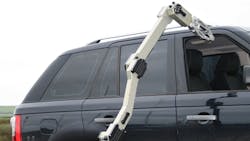11 Law Enforcement Trends Today and Tomorrow
I’ve been in the law enforcement industry for quite a while and this has been a crazy year, especially when it comes to trends. Here are 11 important trends I saw emerge in 2017:
1) Social trend: Increase in danger to law enforcement
In the past few years, I thought that common sense would become the norm again and random attacks on LEOs would stop. Unfortunately, more fuel from the media, higher education, professional sports and celebrities are increasing the need for semper vigilis. This is one trend I hope ends in 2018.
2) Mini trends: Laws and drop tests
This year also had everyone dropping their P320s in order to create a solution looking for a problem. I tested one this year and found it was very serviceable. I did not drop it, and therefore was not fashionable.
In the firearms forums, I have seen more “firearms-experts-who-have-probably-never-fired-a-real-firearm-in-their-life” than ever. Apparently there are some whose original act even left them “traumatized.”
Finally, there are some states who have invented new shooting protocol like having to disassemble firearms in order to change magazines. One trend I have identified is really quite comical. Brilliant engineers exist and they have designed products that easily overcome these useless laws.
3) Firearms accessories trend: Follow the money
This is perhaps the most encouraging trend of 2017, and I pray it continues through 2018. The firearms accessory industry has stepped up to the plate in support of our TBL brothers and sisters.
Five percent of the proceeds for Otis Thin Blue Line Ripcord cleaning kits have been going to the National Law Enforcement Officers Memorial Fund since Police Week 2017. This drive continued until December 2017. Not only is it one of my favorite portable cleaning kits, each kit features two exclusive blue and gray Otis Ripcords. So far, Apex Tactical Specialties has donated $50,000 to C.O.P.S. (Concerns of Police Survivors) from the sale of Thin Blue Line Series of triggers. I’m running one on my Shield. It’s worth every dime.
I know that it is smart business to support a cause while marketing a product, but these businesses chose these causes. For that reason, I am behind them.
4) Knives trend: Flippers
All across the industry, everyone seems to be making “flippers”, folders that have a protrusion opposite the blade side that flips the blade out quickly. I wouldn’t get excited about the opening method, except the mechanism usually doubles as a handguard, which gives them more utility.
Benchmade has an affordable Model 320, Precinct Flipper ($123.25 at knifeart.com). This is a lightweight 154CM drop point with textured G10 scales.
Emerson Knives has upped the ante with their Emerson Sheepdog, which has both the Wave, Flipper and a thumb disc opening in a single design. Also of 154CM and G10, it features a double flat grind on their meaty 3.5” spear point.
CRKT RTD, named for and inspired by the Ruger 10/22 Takedown, has lightweight, glass filled scales.
5) Body armor trend: More educated consumer, better solutions
I had my friends from ShotStop Ballistics have a look at their data to identify this trend. I have had an opportunity to try one of their plates with a 7.62x51 round, which it stopped soundly. Later, I found they did well with 5.56 rounds also. The Duritium construction keeps these plates around two pounds.
The latest body armor products are lighter, thinner and stronger. For example Safariland’s Hardwire products (ballistic panels for duty vests) are Dyneema fibers interlaced in a patented process. They are 14 percent lighter than similar products and more than 60 percent lighter than the monster I wore for duty.
Officers are using more ICW (In Conjunction With) solutions and custom shapes and sizes that meet their duty needs. The products, especially ones released over the past couple of years, are literally the best and safest ever. One thing that has sprung from the latest technology is greater wear rates. The stuff lasts longer.
One more trend: Officers are making more individual purchases or using “community” money for their armor. I don’t know if this is a bad or good trend, but it sure has made a much more educated consumer.
6) Cartridge trend: 6.5 Creedmor
The 6.5 Creedmor or 6.5 CM, is a relatively new cartridge, based on the 30 T/C case. Developed by Hornady in 2007, the 6.5 CM has already shown it can give the .308.
Bullet weights run from about 120 to 160 grains and velocities can run 2,500 to 3,000 fps. Since the 6.5 CM is a shorter case, it works in shorter actions, but most offerings are AR-10 platforms. The 6.5 CM has gone the usual route from target to hunting cartridge availability. The cycle is finally going from hunting to tactical cartridges. Some competitors have already tapped into the 1 km distance capabilities of this cartridge.
Since Federal already has a polymer-tipped 120 grain cartridge, expect a law enforcement version eventually.
Smith & Wesson has a M&P10 6.5 Creedmoor with a Magpul MOE Rifle Stock, 5R rifling and Free-Float Troy M-LOK Handguard.
Savage has a 10FCP-SR bolt gun and an MSR-10 semi available now. The MSR-10 is a custom forged, compact version of the AR-10 design. It has a non-reciprocating side charging handle, which adds to the ergonomics of the package, and a BLACKHAWK! AR Blaze two-stage target trigger. The package is finished off with a Magpul PRS Gen3 buttstock.
If you notice, both Savage and S&W run 1/8 5R rifling barrels. 1/8 R5 mid-length barrels seem to be the sweet spot for 6.5 CM.
While I don’t think the 6.5 CM will completely displace the .308 or other 30 caliber products, I do think there is a place for this cartridge in law enforcement.7) Shotgun trend: Real short and magazine-fed
The two trends in shotgun products are at the opposite end of the spectrum. Ever since Mossberg introduced the 14” non-NFA Shockwave, a really short shotgun with a birds head grip, and their Compact Cruisers, AOW versions of the 500 and 590, everyone wants one.
Remington followed up with the TAC-14. All of these short shotguns are fairly inexpensive, as shotguns go.
The second trend is something RIA (Rock Island Armory) is spearheading. These are magazine-fed shotguns. Several companies have designed conversions, but RIA has a purpose built one, designed to hold 5x3” 12 gauge shells per magazine. The operation should be familiar. They are loosely based on an AR-15 form factor.
8) Cartridge trend: Polymer and non-traditional bullet materials
Non-traditional bullets–bullets that are not composed of the usual lead and copper jacket combination–have become more popular lately. Some companies have legitimately been driven by the quest for better terminal ballistics. Others are a product of pseudo-scientists who believe that animals will forgo any real food and ingest only discarded lead. In any case, some of the innovations in non lead cartridges have been amazing.
CCI’s California-legal bullet with new CCI Copper-22 uses a projectile constructed from a unique mix of copper particles and polymer compressed into a 21-grain hollow-point.
The G2 Research Telos uses a solid copper bullet that segments when it hits its intended target, sending these segments in different directions, creating different wound channels.
Federal has launched the Syntech Total Synthetic Jacket (TSJ) as a reloading component. It also comes as loaded ammunition in their American Eagle line. This is a polymer encased compressed powder bullet.
Casing bullets in polymer can reduce fouling, make guns easier to clean and potentially lower pressures for the same performance. Polymer cased bullets may make indoor shooting somewhat safer.
The reloading industry has also responded to this trend. Using polymer can mean that conventional powders may dissolve the bullet base after ignition. Alliant Powder Sport Pistol powder was designed for reloaders who use non-traditional loads.
9) Technology trend: Smaller robots
Critical incident units in the field have gone with more portable robots with a variety of features, rather than bulky ones that take special vehicles or equipment to deploy them at a scene. Take a look at the Med-Eng Avenger Remotely Operated Vehicle (ROV).
10) Holster trend: Modular design holsters
Holster makers have begun to take single designs and adapt them to fit a variety of guns, using the same platform. These products use a single platform, allowing the swapping of “shells”. Most notable is Yeti-Tac, who uses an RTI system that allows officers to buy one mounting system and any number of “shells” that fit it.
BLACKHAWK! released the Omnivore Holster this year, which will mount nearly any gun with an accessory rail, eliminating questions about size, fit and duty application. It has an active retention system and will fit about 150 guns so far.
11) Handgun trend: Guns are getting cheaper
Since we can always expect to see handgun revews here, I want to just give you a heads up for 2018. The bargain priced guns are getting better, and most handguns are getting cheaper. There is plenty of speculation about why guns are getting cheaper, but it’s really a simple supply and demand thing.
Right now, I’m testing an Armscor MAPP FS 9mm, one of the most natural pointing guns I have shot in a long time. From the holster, I am faster and more accurate with it than my EDC gun. Look for the review on it in 2018.

Officer Lindsey Bertomen (ret.), Contributing Editor
Lindsey Bertomen is a retired police officer and retired military small arms trainer. He teaches criminal justice at Hartnell College in Salinas, California, where serves as a POST administrator and firearms instructor. He also teaches civilian firearms classes, enjoys fly fishing, martial arts, and mountain biking. His articles have appeared in print and online for over two decades.





